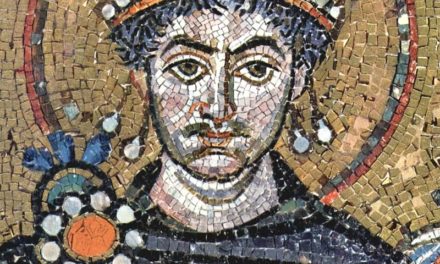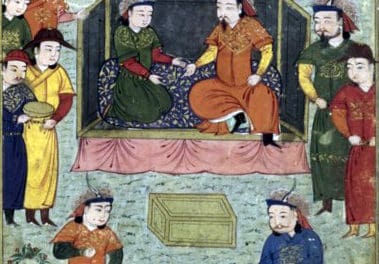This episode of CS the first of a couple summary reviews we’ll do. My plan is to continue on as we have, pausing occasionally to in one episode catch us up in broad strokes on what we’ve covered so far.
My hope is to avoid the whole, “Can’t see the forest for the trees” thing. For those listeners where English is a second language, that phrase is an idiom that means the loss of perspective behind too many details.
Though I want to give a clean straight narrative for our story of the Church, we can’t help but bounce around ab it between times & places. It’s just the nature of trying to examine all of church history, instead of its course in one location. Still, I hope to build a basic sense of historical flow. To that end, stopping every so often to step back and provide a quick summary of the material we’ve covered so far seems appropriate.
Overviews won’t have nearly the detail as a regular episode, but they will have a lot more names & dates since it’s a culling & gleaning of what the last so many episodes have covered.
Okay, here we go with our first Overview . . .
While the Christian Faith began as an inordinately tiny sect within 1st Century Judaism, it grew rapidly, first among Jews, then among Gentiles. This growth can be attributed to two main causes. First, was the generally lethargic spiritual condition of the ancient world, most especially in those regions dominated by the Roman Empire. Several factors conspired to make people ripe for the message the Gospel proclaimed. Second, was the spiritual dynamic provided by early followers of Jesus. They demonstrated an exceptional lifestyle that attracted others. Even while Rome followed an official policy of opposition to the Faith, the number of its adherent grew.
Early Christianity is divided by historians into 2 periods: the Apostolic & Post-Apostolic.
The Apostolic lasts from the mid-1st Century to the early 2nd when the last of the Apostolic Fathers died. The Apostolic Fathers are counted not only as the original disciples of Jesus and their peers but their direct followers; men like Clement of Rome, Ignatius of Antioch & Polycarp.
The Post-Apostolic period stretches from the early 2nd Century to the beginning of the 4th. During this time the leadership of the church moved from direct dependence on the Apostolic Fathers to local church leaders, known as pastors. As the decades passed, these local lead pastors morphed into bishops who oversaw a growing episcopal structure.
This period was marked by episodic & regional persecution of Christians in Roman lands. It wasn’t until the mid to late 3rd Century that persecution became a widespread policy. It ended with the arrival of Emperor Constantine and the Edict of Milan in 313. Names associated with this time are Irenaeus, Justin Martyr, Tertullian, Origen.
Besides persecution, the main challenge the Post-Apostolic church faced was presented by heresy.
Early Christians heeded the New Testament’s repeated call for maintaining correct belief and refuting false teaching. The Faith wasn’t just the philosophical ramblings of a sun-burnt sage. It was rooted in historical events both ancient & recent. When aberrant teachers attempted to hijack core & cardinal doctrines, bishops gathered to study what their Scriptures said and arrive at a consensus. In this way, they refuted the challenge of such groups & teaching as Docetism and its later evolution, Gnosticism. They rebuffed Marcionism, the Ebionites, Manachaeists & the aberrant teaching of Montanus. The greatest threat rose from a Bishop named Arius who denied Jesus’ deity. Though Arianism was officially quashed at the First of the Great or what are called Ecumenical Councils held at Nicaea in 325, it continued to be espoused in many regions for the next century and a half. The Council of Nicaea established the orthodox Christian position today known as Trinitarianism, which holds that God is one in essence while three in persons. While 300 bishops signed the Nicaean Creed, many of them went away from the Council unsettled about the terminology used in the Creed to define the correct view of God. The task of sharpening the terms & arriving at the proper description of the Biblical doctrine of the Trinity was left to the Cappadocian Fathers some time later.
The Post-Apostolic period is also when the Church Fathers realized the need to provide a definitive list of books that comprised the Bible. The work of several councils finally closed the Canon during this time.
The Post-Apostolic Period was followed by what’s often called Catholic Christianity; not to be confused with ROMAN Catholic. The term ‘catholic’ means universal and stands in contrast to the many often subtle doctrinal challenges that arose following the Council of Nicaea. This period, stretching from the beginning of the 4th Century to the end of the 5th saw 7 major Church Councils that all met to address some new or renewed challenge to orthodoxy, specifically as it related to the theological can of worms the First Council at Nicaea opened, and maybe we should say, sought to close. You see, once the Church settled on the Trinity as the right way to understand God, the main questions were;
1) How do the persons of the Godhead relate to one another?
2) How are we to understand the person of Jesus? How do we reconcile Him as both God & Man?
This second issue ended up in sometimes bloody brawls as advocates of different positions used the debate to secure political favor & religious prestige.
During this period of Catholic Christianity, 4 cities rose as the gravitational centers of the Christian world; Rome, Alexandria, Antioch, & the new capital of the Empire, Constantinople. Alexandria, Antioch & Constantinople were all in the East while Rome was alone in the West. The main contest for prestige & power was between Alexandria & Antioch which used 2 different ways of interpreting Scripture and understanding the Person & Nature of Christ. Alexandria had a long reputation as a center of scholarship but Antioch continually produced excellent preachers. Since the Church at Constantinople, being near the royal palace, was the premier church in terms of securing imperial favor, whoever was the bishop there tended to secure favor for his side of the debate. It infuriated many of the bishops at Alexandria that Antioch kept providing new leaders for the Church at Constantinople. The supreme example of all this is the verbal and at times physical brawl that took place between Cyril of Alexandria and Nestorius from Antioch, who became Bishop at Constantinople.
It was during this time as well that the Church at Rome emerged to become, not just the lead church in the West, but over the entire Empire. One of the reasons for this is the generally excellent leadership the Roman Bishops provided. When the Eastern churches were wracked by debate, Rome often played a mediating influence or lent a perspective that resolved the issue.
What encouraged Rome’s emergence as the lead church in the Faith was the claim of some Roman Bishops that they were spiritual heirs to Peter’s spiritual hegemony. That claim was not without considerable push-back by many, but it eventually proved persuasive so that Rome was given tacit, if not outright honor as the lead church.
Again, it was during this era the Ecumenical Councils were convened. They were concerned largely with settling the Christological disputes tearing apart the Church. The First Council of Nicaea in 325 & First Council of Constantinople in 381 condemned Arianism. The Council of Ephesus in 431 condemned Nestorianism and affirmed Mary as the Theotokos; that is the “Mother of God.”
The Council of Chalcedon just 20 years later affirmed that Christ had two natures; He was fully God and fully man, yet was one person. It specifically condemned Monophysitism, the belief that Jesus’ divine nature overwhelmed his human nature. Following Chalcedon, several groups broke with the orthodox, or what we would call from this time, Catholic position; again, not Roman Catholic. The term simply means what was the accepted position of the Church & churches of the Roman World. The churches of Egypt, headquartered at Alexandria tended to be Monophysite while the churches that moved into the East followed a distorted view of Nestorius’ & began to adopt the idea that Jesus was not only of two natures, He was two persons in a single body. As we’ve seen in previous episodes, it’s unlikely Nestorius himself believed that, though his opponents claimed he did, and his later followers do seem to have moved in that direction.
One of the most significant events of this period occurred in late February of 380. Emperor Theodosius I signed the Edict of Thessalonica which made Catholic, Trinitarian Christianity the official state religion of the Roman Empire. Prior to this the Emperors Constantius II & Valens favored Arian flavors of the Faith. Theodosius I declared the Trinitarianism of the Nicene Creed as the perennial position of the Empire. While there were going to be all kinds of problems associated with making Christianity the State religion, what ensured it would really go awry was that Theodosius went further and in effect outlawed unbelief; any belief but Catholic Christianity was deemed heretical. Heretics weren’t just put out of the Church, they were put out of life!
It didn’t take long for the Church to avail itself of the Imperial organizational structure, adopting similar geographical borders. They even kept the old imperial name – Diocese. Bishops oversaw the various dioceses. The bishop’s home was known as a seat, or see.
Back-tracking a bit, when Christians were being persecuted during the 2 and 3rd Centuries in the West, many of them fled for refuge to the East and the Sassanid Empire, the long-time enemy of Rome. Though the Sassanids were Zoroastrians, they welcomed the Christians because, you know, the enemy of my enemy is my friend.
When Rome became a Christian State, the Sassanids feared the Christians would become a kind of religious Fifth Column and began persecuting them. The once vibrant Persian church was decimated and many of these Eastern Christians fled even further East, becoming what is today referred to as the Church of the East.
As we’ve seen in recent episodes, Monasticism became a standard feature of Christianity during the time of Catholic Christianity and carried on for centuries after in the Middle Ages.
While there are dozens of names associated with this time, we’ll limit our list to a few as we wrap up this episode.
There are the Cappadocian Fathers: Basil the Great, his brother Gregory of Nyssa and their friend, Gregory of Nazianzus.
There’s the Popes Damasus I & Leo the Great.
We’ve mentioned Cyril of Alexandria & his nemesis, the defrocked & banished Nestorius.
There’s the astoundingly gifted Bishop of Milan, Ambrose and his student who eventually outshined his teacher – Augustine.
This is the time of Jerome & the Golden-tongued Chrysostom.
It’s the time Attila the Hun and Alaric whose Goths sacked Rome.
It’s the age of the Vandals who are such brutes they give their name to bad behavior.
This is also the time of an interesting character whose life has become a thing of legend – Patrick of Ireland. We’ll take a look at him soon.
The Era of Catholic Christianity ends in the late 5th Century with the Fall of the Western Roman Empire. This is of course an arbitrary line we draw, especially when we consider that the Eastern Empire saw itself as the continuation of the Empire for another thousand years.
But most historians see the Fall of the Western Roman Empire as a momentous event that leveled a blow to the European mindset it took centuries to recover from. Thus, the period between the Roman Empire and the Modern Era is called the Middle Ages. And while it’s been fashionable for a long time in the popular idea of history to see the Middle Ages as Dark and a long stretch when nothing of much consequence happened, the more astute student knows the Middle Ages were a time of amazing development.






Do you have any of this in pdf form? I would love to be able to use this is a class setting.